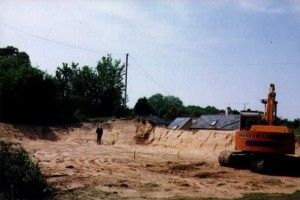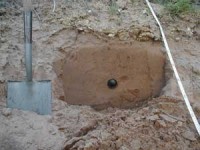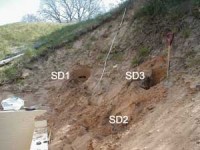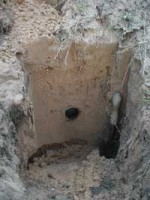 Between the year 1665 and 1670 sandstorms took place which threatened to overwhelm the village of Santon Downham and silted up the river between Thetford and Brandon. The following is an interpretation of an account given in a letter by Thomas Wright Esq. to The Royal Society in 1668. He was living in Santon Downham at the time. He said that he found some difficulty in tracing these wonderful sands to their origin, but he found it to be in a warren in Lakenheath; a town about five miles south-west of Santon Downham. Here some great sand hills broken by the tempestuous south-west winds were blown upon some adjacent ground. This being of the same nature and having only a thin coat of grass over it, which was soon rotted because of the other sand lying on it.
Between the year 1665 and 1670 sandstorms took place which threatened to overwhelm the village of Santon Downham and silted up the river between Thetford and Brandon. The following is an interpretation of an account given in a letter by Thomas Wright Esq. to The Royal Society in 1668. He was living in Santon Downham at the time. He said that he found some difficulty in tracing these wonderful sands to their origin, but he found it to be in a warren in Lakenheath; a town about five miles south-west of Santon Downham. Here some great sand hills broken by the tempestuous south-west winds were blown upon some adjacent ground. This being of the same nature and having only a thin coat of grass over it, which was soon rotted because of the other sand lying on it.
It joined the Lakenheath sand, increased its mass, and accompanied its strange progress. Mr Wright supposes that at the first eruption the sand did not cover more than eight or ten acres of ground; but before it had travelled four miles from its first abode it increased so much that it covered more than a thousand. All the opposition the sand met with from Lakenheath to Downham was from one farm house. The owner endeavoured to secure this by building bulwarks against the sand; but perceiving this would not answer his purpose he changed his plan. Instead of trying to prevent its approach he removed all the bulwarks and fences so that the sand could have free passage. In four or five years time he was nearly rid of it. It was about thirty or forty years before the writing of this account that the sand reached Downham, where it continued for ten or twelve years in the outskirts of the town without doing considerable damage. The reason for which (Mr Wright imagined) was because its current was then downhill which sheltered it from those winds which gave it motion. The valley being once passed, it went about a mile up hill in two months time, and over-ran about 200 acres of very good corn land the same year.
(Here Mr. Wright goes on to describe the damage caused by the sand in Santon Downham) “It is now got into the body of this little town, where it hath buried and destroyed diverse tenements and other houses and hath forced us to preserve the remainder at a greater expense than they are worth.” Mr. Wright made enormous efforts to save his farmhouse and land, though for four or five years his success was doubtful. The sand had blocked all his avenues so that there was no passage to him, except over two walls that were eight or nine feet high which encompassed a small grove in front of his house. At one time his yard was buried. The sand had blown almost up to the eves of his out houses. At the other end it had broken down his garden wall and stopped all passage that way.
For four or five years Mr.Wright stopped it as well as he could. For month after month, year after year, he constructed furze hedges. As fast as they were overwhelmed he raised fresh ones on top of the others. Eventually he had mighty ramparts some 60 feet in height. Because of these ramparts the sand was confined to a space of nine to ten acres. Into this sand Mr. Wright mixed hundreds of loads of good soil and manure. In one year he had managed to reduce it again to fertile land. He then cleared all his walls, and with the assistance of his neighbours, who helped him cart away1500 loads in a month, he cut a passage to his house through the main body of sand. The other end of the village met with a worse fate where many houses were overthrown or buried.
The pastures and meadows, (which for so small a village were considerable), were over-run and destroyed. The river was so full of sand that boats transporting goods between Thetford and Brandon were unable to carrying as much cargo as they had done before. Today there is little evidence of the sand flood in Santon Downham except in Hall Drive, which is believed to be the approach to Mr. Wright’s house. For many years there was a high sand bank on one side .In the latter part of 1999 this bank was partially removed to build a new house.
The sand flood has been the subject of both a Radio programme and Scientific Investigation in recent years.
Reference: Thomas Wright 1668.Philosophical Transactions of the Royal Society of London. 3, 722-725.
Ronnie Moran ©2000



